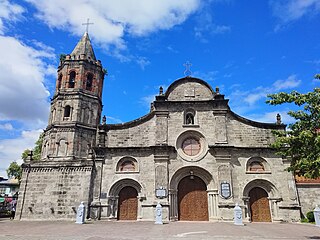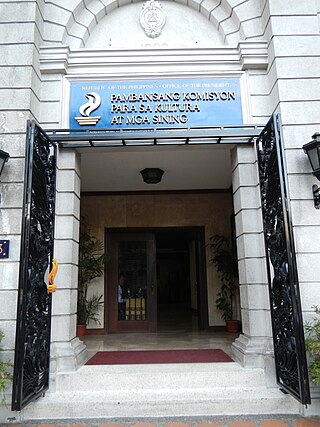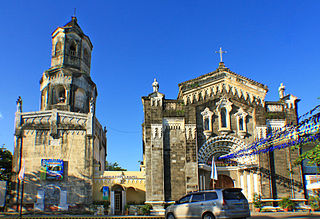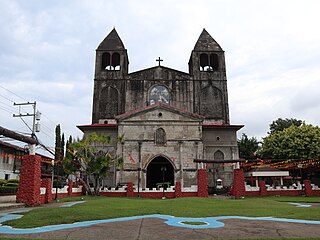This article needs additional citations for verification .(April 2015) |
The following lists down built heritage found in Bulakan, Bulacan, Philippines pursuant to the Republic Act No. 10066 or the National Cultural Heritage Act of 2009. [1]
This article needs additional citations for verification .(April 2015) |
The following lists down built heritage found in Bulakan, Bulacan, Philippines pursuant to the Republic Act No. 10066 or the National Cultural Heritage Act of 2009. [1]

Bulacan, officially the Province of Bulacan, is a province in the Philippines located in the Central Luzon region. Its capital is the city of Malolos. Bulacan was established on August 15, 1578, and part of the Metro Luzon Urban Beltway Super Region.

Meycauayan, officially the City of Meycauayan, is a 1st class component city in the province of Bulacan, Philippines. According to the 2020 census, it has a population of 225,673 people. It is one of the oldest towns in the province.

Bulakan, officially the Municipality of Bulakan, is a 1st class municipality in the province of Bulacan, Philippines. According to the 2020 census, it has a population of 81,232 people.

Malolos, officially the City of Malolos, is a 3rd class component city and capital of the province of Bulacan, Philippines. According to the 2020 census, it has a population of 261,189 people. It is the capital city of the province of Bulacan as the seat of the provincial government.

Balagtas, officially the Municipality of Balagtas, is a 1st class municipality in the province of Bulacan, Philippines. According to the 2020 census, it has a population of 77,018 people.

The National Commission for Culture and the Arts of the Philippines is the official government agency for culture in the Philippines. It is the overall policy making body, coordinating, and grants giving agency for the preservation, development and promotion of Philippine arts and culture; an executing agency for the policies it formulates; and task to administering the National Endowment Fund for Culture and the Arts (NEFCA) – fund exclusively for the implementation of culture and arts programs and projects.

The legislative districts of Bulacan are the representations of the province of Bulacan in the various national legislatures of the Philippines. The province is currently represented in the lower house of the Congress of the Philippines through its first, second, third, fourth, fifth and sixth congressional districts.

Bulacan State University is a public university in Bulacan province, Philippines. Its main campus is in Malolos.
Bulacan is a province of the Philippines. It was established on 15 August 1578.

The Philippine Registry of Cultural Property, abbreviated as PRECUP, is a national registry of the Philippine Government used to consolidate in one record all cultural property that are deemed important to the cultural heritage, tangible and intangible, of the Philippines. On June 11, 2018, the entries in the newly updated PRECUP was at 3,921. Additionally, 1,259 out of 1,715 LGUs, or 73 percent of LGUs have established local cultural inventories (LCI).

Ancestral houses of the Philippines or Heritage Houses are homes owned and preserved by the same family for several generations as part of the Filipino family culture. It corresponds to long tradition by Filipino people of giving reverence for ancestors and elders. Houses could be a simple house to a mansion. The most common ones are the "Bahay na Bato". Some houses of prominent families had become points of interest or museums in their community because of its cultural, architectural or historical significance. These houses that are deemed of significant importance to the Filipino culture are declared Heritage House by the National Historical Commission of the Philippines (NHCP), previously known as the National Historical Institute (NHI) of the Philippines. Preservation is of utmost importance as some ancestral houses have come into danger due to business people who buy old houses in the provinces, dismantle them then sell the parts as ancestral building materials for homeowners wishing to have the ancestral ambiance on their houses. These ancestral houses provide the current generation a look back of the country's colonial past through these old houses.

Biak-na-Bato National Park is a protected area of the Philippines located almost entirely within Barangay Biak-na-Bato in San Miguel, Bulacan from where it derives its name. The park also extends to the nearby municipalities of San Ildefonso and Doña Remedios Trinidad covering a total area of 2,117 hectares. It was declared a national park in 1937 by President Manuel L. Quezon by virtue of its association with the history and site of the Biak-na-Bato Republic. The park consists of a cave network and a system of rivers and trails of both historical and ecological importance. Situated only 80 kilometers (50 mi) northeast from Manila, it is fast becoming a popular weekend eco-adventure destination for the city dwellers.

The National Cultural Heritage Act, officially designated as Republic Act No. 10066, is a Philippine law that created the Philippine Registry of Cultural Property (PRECUP) and took other steps to preserve historic buildings that are over 50 years old. It was signed into law on March 25, 2009.

The Marcelo H. del Pilar Shrine is a declared national shrine by the National Historical Commission of the Philippines in honor of Filipino lawyer, poet and propagandist Marcelo H. del Pilar. Located at Sitio Cupang, Brgy. San Nicolas, Bulakan, Bulacan, the shrine is the former site of the house of the del Pilar clan. Currently, the shrine is under the management of the National Historical Commission of the Philippines.

The Diocesan Shrine and Parish of Nuestra Señora de la Asuncion, commonly known as the Bulakan Church, is a 19th-century Neo-Byzantine-Romanesque stone church located at Brgy. San Jose, in the Municipality of Bulakan, Bulacan province, Philippines. It is one of the parishes of the Roman Catholic Diocese of Malolos under the Vicariate of the Immaculate Conception. The church was declared Marked Historical Structure of the Philippines in 2007 by the National Historical Institute, the precursor of the National Historical Commission of the Philippines. A historical marker bearing a brief history of the church was installed by the commission.

The Malolos Historic Town Center is a historic district located in downtown Malolos City, Bulacan, Philippines, commonly called the Camestisuhan or Pariancillo District of Malolos. It was declared as such for its collection of Spanish and American-era houses and government structures, and for being the birthplace of the First Philippine Republic and the Malolos Constitution as well as having been the capital of the Philippines from 1898 to 1900. The National Historical Institute declared the downtown Malolos area officially as a National Historical Landmark and a Heritage Town on August 15, 2001.

The Pila Historic Town Center is a historic district located at Barangay Santa Clara Norte, Pila, Laguna, Philippines. The district preserves examples of Spanish and American-era architecture found in its town proper laid out with the Spanish colonial town planning system for the Indies and is also a pre-Hispanic archaeological site. The National Historical Institute declared a specific portion of Pila as a National Historical Landmark in 2000.

The Dapitan Heritage Zone or Dapitan Historic Center is a declared historic district in Dapitan, Philippines. Because of its prehistoric origins, collection of heritage structures and role in the exile of local patriot Dr. Jose Rizal, the National Historical Commission of the Philippines declared a specific portion of the city, along with its heritage structures, as a Heritage Zone or Historic Center in 2011. The declaration was made in coordination with the 150th birth anniversary of Dr. Rizal in June 2011.
Heritage management in the Philippines is guided by laws and agencies that create regulations for potentially destructive behaviors such as excavations and demolition. Legislation pertaining to heritage management consists of Republic Acts and Presidential Decrees. Organizations such as UNESCO, the National Commission for Culture and the Arts, and the Heritage Conservation Society are also referred to in laws.

Bulacan's 1st congressional district is one of the seven congressional districts of the Philippines in the province of Bulacan. It has been represented in the House of Representatives of the Philippines since 1916 and earlier in the Philippine Assembly from 1907 to 1916. The district consists of the provincial capital city of Malolos and adjacent municipalities of Bulakan, Calumpit, Hagonoy, Paombong and Pulilan. It is currently represented in the 19th Congress by Danilo A. Domingo of the National Unity Party (NUP).